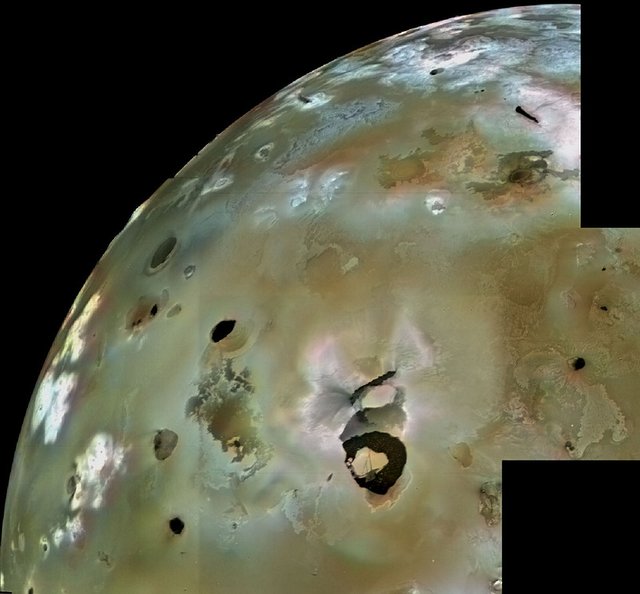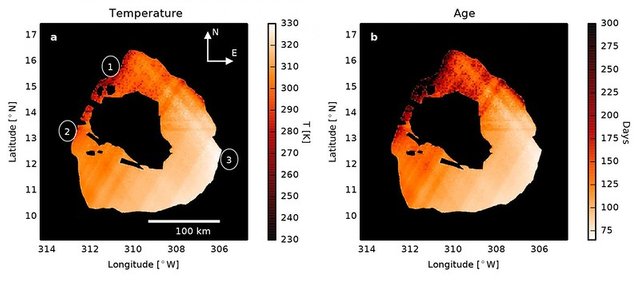Giant waves of molten lava detected on Jupiter's moon Io
Most part of data about Jupiter four largest moons is obtained since 1995 to 2003, when spacecraft Galileo orbited Jovian system. In the last time, all attention was given to Europa with its subsurface water ocean, while another moon Io, the most volcanically active body in the solar system was neglected. Europa and Io together are "A Song of Ice and Fire" in reality, only without dragons.

Image: NASA - Io in enhanced colors, imaged by Galileo probe. Loki Patera - black feature with bright "island"
After Galileo finished its mission and was sent in Jupiter atmosphere in 2003, Earth has no eyes in Jupiter's satellite system. Juno, the only spacecraft, orbiting Jupiter, is located on orbit, almost perpendicular to moons' orbits and cannot image them. So, to look close at Io volcanic surface, scientists have to invent new tricks.
Taking advantage of a rare orbital alignment between two of Jupiter's moons, Io and Europa, researchers have obtained an exceptionally detailed map of the largest lava lake on Io, the most volcanically active body in the solar system. On March, 2015, Europa passed in front of Io (as seen from the Earth), gradually blocking out light from the volcanic moon. The infrared data showed that the surface temperature of Io's massive molten lake Loki Patera steadily increased from one end to the other, suggesting that the lava had overturned in two waves that each swept from west to east at about a kilometer per day.
Loki Patera is sea of molten lava about 200 kilometers in diameter, with surface area of hot region 21 500 square kilometers.
New findings are published on May 11 In Nature journal. The images were obtained by the twin 8.4 meter mirrors of the Large Binocular Telescope Observatory.
Europa took about 10 seconds to completely cover Loki Patera.
Said Michael Skrutskie, of the University of Virginia, co-author of the article:
There was so much infrared light available that we could slice the observations into one-eighth-second intervals during which the edge of Europa advanced only a few kilometers across Io's surface. Loki was covered from one direction but revealed from another, just the arrangement needed to make a real map of the distribution of warm surface within the patera.
These observations gave the astronomers a two-dimensional thermal map of Loki Patera with a resolution better than 10 kilometers (6.25 miles). The temperature map revealed a smooth temperature variation across the surface of the lake, from about 270 Kelvin at the western end, where the overturning appeared to have started, to 330 Kelvin at the southeastern end, where the overturned lava was freshest and hottest.

Image: Large Binocular Telescope Observatory - Maps of the temperature and lava crust age within Loki Patera, derived from the LBTO observations. The higher temperatures in the southeast (location 3) indicate that new magma was exposed most recently in this location
Next chance to use this method to study Loki Patera will happen only in 2021, when next alignment of Io and Europa will happen.
Direct study of Io is extremely difficult, as it orbits Jupiter in the middle of its radiation belt. The new mission Europa Clipper, planned for launch around 2022 has no plans to Io flyby .
For further reading: Multi-phase volcanic resurfacing at Loki Patera on Io